This is my current code and it displays in a window but literally prints it the way I've typed it (obviously). But is there a way to write these so they are displayed as powers/exponents? "
questionNum = 0
#SET QUESTIONS HERE
questions = [0,"Given that y = x^4 + 6x^1/2, find dy/dx","Write down the value of 125^1/3","Fully factorise 9x^2 - 25","Find the value of 8^5/3"]
answer1 = [0,"4x^4 + 3x^1/2","25","(3x-5)(3x+5)","1/2"]
answer2 = [0,"4x^3 + 6x^1/2","1/5","(3x+5)(3x+5)","Answer 2 (4)"]
answer3 = [0,"4x^3 + 6x^-1/2","5","(3x-5)(3x-5)","Answer 3 (4)"]
answer4 = [0,"4x^3 + 1/2x^-3/2","125","(9x+5)(x-5)","Answer 4 (4)"]
This is what it looks like:

rightanswers = [0,1,2,3,4] #These are the correct answers
"
This is the bit that needs to be changed. I've added the rest just in case you need any of it to see what's going on:
from tkinter import * #The TKinter module imported in order to create the menus
import sys #Invoke functions and statements - allows operations to work and searches for named modules i.e. TKinter
global questionNum #Connections between functinos and arrays
questionNum = 0
#SET QUESTIONS HERE
questions = [0,"Given that y = x^4 + 6x^1/2, find dy/dx","Write down the value of 125^1/3","Fully factorise 9x^2 - 25","Find the value of 8^5/3"] #This is the question bank which has been set up as an array
answer1 = [0,"4x^4 + 3x^1/2","25","(3x-5)(3x+5)","1/2"] #These are the possible answers - this is where multiple choice answers would go
answer2 = [0,"4x^3 + 6x^1/2","1/5","(3x+5)(3x+5)","Answer 2 (4)"]
answer3 = [0,"4x^3 + 6x^-1/2","5","(3x-5)(3x-5)","Answer 3 (4)"]
answer4 = [0,"4x^3 + 1/2x^-3/2","125","(9x+5)(x-5)","Answer 4 (4)"]
rightanswers = [0,1,2,3,4] #These are the correct answers
normal = Tk() #Build the TKinter
normal.geometry("850x350") #Set the size of the normal chess form to 850x350
normal.title("Normal Chess") #Sets a title for the normal chess form
normal.columnconfigure(1,minsize = 300) #This is whereabouts the question and answers are displayed
questionVar = StringVar() #Question will be a string
answerVar = IntVar() #Answers will be numbers
answerVar.set(1) #Questions can only have one solution
aText = StringVar() #Text for the answers - options
bText = StringVar()
cText = StringVar()
dText = StringVar()
qNoText = StringVar() #Questions text which is displayed to the user
questionText = StringVar()
normal.withdraw() #Allows the user to only select one option
title = Tk() #Builds the TKinter
title.title("Chess") #Title of the form
title.geometry("300x300") #The size of the image
watermark = PhotoImage(file = "watermark.gif") #Link to the image itself
Label(image = watermark).place(x=0,y=0,relwidth=1,relheight=1) #Places the image onto the form set on the x,y coordinates
title.withdraw()
menu = Tk() #Builds the TKinter
menu.title("Main Menu") #Displays 'Main Menu' on screen
menu.geometry("400x350") #Size of the form
p1var = StringVar() #Sets a variable for Player 1 and Player 2
p2var = StringVar()
def Quit(): #Quit function - allows the user to exit the program
menu.destroy()
title.destroy()
normal.destroy()
sys.exit() #Gets rid of all the modules
def play():
title.deiconify()
Label(title,text = "Enter Details:",font = ("Calibri",25)).grid(row = 1, column = 1)
#'Enter Details' font, size and location on the form
Label(title,text = "CHESS",font = ("Calibri",50)).grid(row = 0,column = 1)
#'CHESS' font, size and location on the form
Label(title, text = "Player 1: ").grid(row = 2,column = 0)
#'Player 1' font, size and location on the form
Entry(title,textvariable = p1var,width = 30).grid(row = 2,column = 1)
#Allows the user to input a string for the player 1 name
Label(title, text = "Player 2: ").grid(row = 3,column = 0)
#'Player 2' font, size and location on the form
Entry(title,textvariable = p2var,width = 30).grid(row = 3,column = 1)
#Allows the user to input a string for the player 2 name
Label(title,text = "Select Game Mode: ").grid(row = 4,column = 1)
#'Select Game Mode: ' font, size and location on the form
Button(title,command = lambda: playNormalChess(p1var.get(),p2var.get()),text = "Normal Chess").grid(row = 6,column = 1,sticky = W)
#Button for normal chess
Button(title,command = lambda: playSpeedChess(p1var.get(),p2var.get()),text = "Speed Chess").grid(row = 6,column = 1,sticky = E)
#Button for speed chess
Button(title,command = instructions,text = "Instructions").grid(row = 7,column = 1,pady =10)
#Button for instructions
def playNormalChess(p1,p2):
normal.deiconify()
t = Label(textvariable = qNoText,font = ("Arial",50)).grid(row = 0,column = 1,sticky = W,columnspan=2,padx = 20,pady =10)
#Functions for selection
q =Label(textvariable = questionVar,font = ("Arial",30)).grid(row = 1,column = 1,sticky = W,columnspan=2,padx = 20,pady =10)
#Font and size the questions are set in
a=Radiobutton(variable = answerVar,value = 1,textvariable = aText,font = ("Arial",18)).grid(row = 3,column = 1,pady =5,padx = 20,sticky = W)
#These are the radio buttons which are linked to the answers - set the font and the size of the text
b=Radiobutton(variable = answerVar,value = 2,textvariable = bText,font = ("Arial",18)).grid(row = 4,column = 1,padx = 20,sticky = W)
c=Radiobutton(variable = answerVar,value = 3,textvariable = cText,font = ("Arial",18)).grid(row =5,column = 1,pady = 5,padx = 20,sticky = W)
d=Radiobutton(variable = answerVar,value=4,textvariable = dText,font = ("Arial",18)).grid(row = 6,column = 1,padx = 20,sticky = W)
Button(text = "Submit",command = confirm).grid(row =0,column = 3,sticky = W,pady = 10) #Submit button to confirm their answers
newQuestion() #Calls the function for a new question
def confirm():
if messagebox.askyesno('Confirm','Are You Sure?'): #This is the conformation of the correct answer for the user
try:
if answerVar.get() == rightanswers[questionNum]: #If they select yes to confirm they are happy with the selection
# - it checks their answer with the correct answer and prints 'Right' or 'Wrong' depending on their answer
print("Right")
else:
print("Wrong")
newQuestion() #Once their question is answered, a new question will be presented to them
except IndexError:
print("No more Questions")
def newQuestion():
global questionNum
questionNum = questionNum + 1
try:
qNoText.set("Question "+str(questionNum))
aText.set(answer1[questionNum])
bText.set(answer2[questionNum])
cText.set(answer3[questionNum])
dText.set(answer4[questionNum])
questionVar.set(questions[questionNum])
except IndexError:
print("No more questions")
Label(menu,text = "AS Maths Chess",font = ("Arial",37)).pack(pady = 20)
Button(menu,text = "Play",background = "black",foreground = "white",font = ("Arial",20),command = play).pack(ipadx = 80,ipady = 20, pady = 10)
Button(menu,text = "Quit",font = ("Arial",20),command = Quit).pack(ipadx = 80,ipady = 20, pady = 10)